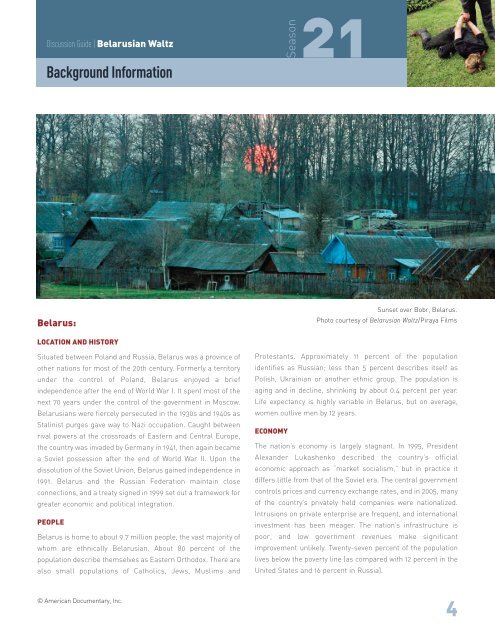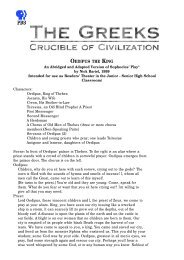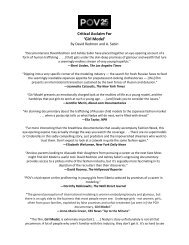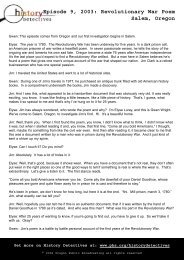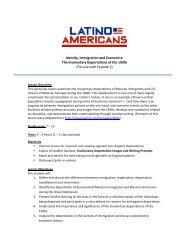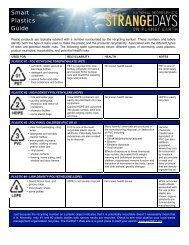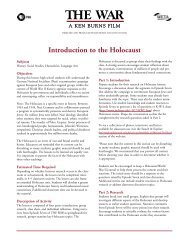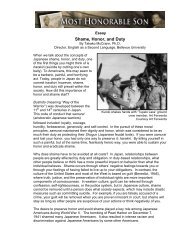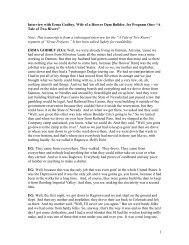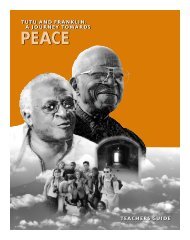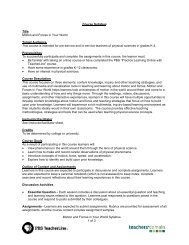DG - Belarusian Waltz - PBS
DG - Belarusian Waltz - PBS
DG - Belarusian Waltz - PBS
- No tags were found...
Create successful ePaper yourself
Turn your PDF publications into a flip-book with our unique Google optimized e-Paper software.
Discussion Guide | <strong>Belarusian</strong> <strong>Waltz</strong>Background InformationSeason21Belarus:LOCATION AND HISTORYSunset over Bobr, Belarus.Photo courtesy of <strong>Belarusian</strong> <strong>Waltz</strong>/Piraya FilmsSituated between Poland and Russia, Belarus was a province ofother nations for most of the 20th century. Formerly a territoryunder the control of Poland, Belarus enjoyed a briefindependence after the end of World War I. It spent most of thenext 70 years under the control of the government in Moscow.<strong>Belarusian</strong>s were fiercely persecuted in the 1930s and 1940s asStalinist purges gave way to Nazi occupation. Caught betweenrival powers at the crossroads of Eastern and Central Europe,the country was invaded by Germany in 1941, then again becamea Soviet possession after the end of World War II. Upon thedissolution of the Soviet Union, Belarus gained independence in1991. Belarus and the Russian Federation maintain closeconnections, and a treaty signed in 1999 set out a framework forgreater economic and political integration.PEOPLEBelarus is home to about 9.7 million people, the vast majority ofwhom are ethnically <strong>Belarusian</strong>. About 80 percent of thepopulation describe themselves as Eastern Orthodox. There arealso small populations of Catholics, Jews, Muslims andProtestants. Approximately 11 percent of the populationidentifies as Russian; less than 5 percent describes itself asPolish, Ukrainian or another ethnic group. The population isaging and in decline, shrinking by about 0.4 percent per year.Life expectancy is highly variable in Belarus, but on average,women outlive men by 12 years.ECONOMYThe nation’s economy is largely stagnant. In 1995, PresidentAlexander Lukashenko described the country’s officialeconomic approach as “market socialism,” but in practice itdiffers little from that of the Soviet era. The central governmentcontrols prices and currency exchange rates, and in 2005, manyof the country’s privately held companies were nationalized.Intrusions on private enterprise are frequent, and internationalinvestment has been meager. The nation’s infrastructure ispoor, and low government revenues make significantimprovement unlikely. Twenty-seven percent of the populationlives below the poverty line (as compared with 12 percent in theUnited States and 16 percent in Russia).© American Documentary, Inc.4


